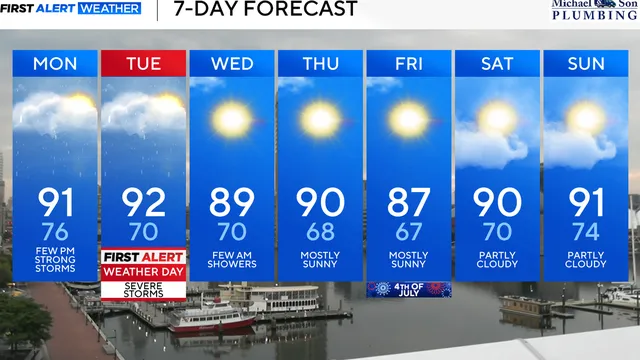
Severe thunderstorms threaten Maryland during extreme heat wave
2025-06-30 08:02- High temperatures and humidity in Maryland led to a Severe Thunderstorm Watch issued for several counties.
- Scattered strong to severe storms are expected throughout the day but particularly from 3 p.m. to 11 p.m.
- Residents are advised to take safety measures due to extreme heat and stormy weather conditions.
Express your sentiment!
Insights
In Maryland, extreme heat persisted over a few days, bringing high temperatures in the low 90s and feels like temperatures soaring to 100 to 105 degrees due to humidity. These adverse weather conditions primed the atmosphere for severe storms, leading to a Severe Thunderstorm Watch being issued for several counties, including Baltimore City, Anne Arundel, and Howard counties, as stormy weather was anticipated especially during the evening commute. Residents were advised to take heat precautions and stay indoors during storms, as severe weather could result in damaging wind gusts, heavy rainfall, and intense lightning. Thunderstorm activity increased significantly on Thursday, with the potential for isolated to numerous strong storms developing throughout the day. The most active period for these storms was expected between 3 p.m. and 11 p.m. Along with thunderstorm activity, a heat advisory was also in place to warn of dangerously high heat indices impacting the local population, especially the sick and elderly. As a cold front approached Maryland, it was forecasted that Friday would bring a drastic drop in temperatures, potentially falling below 80 degrees, marking a welcome relief from the oppressive heat. Forecasters noted that while storms could contribute to this cooling, rain coverage was expected to be spotty across the region. Looking ahead to the weekend, Maryland was set to experience summer weather characterized by seasonable heat and muggy conditions. Although not every neighborhood will experience precipitation, the combination of heat and humidity will likely make temperatures feel warmer than they are. Overall, the consequences of the recent severe weather and heat wave have raised alerts and warnings for residents, emphasizing the need to stay informed and prepared for rapidly changing weather conditions.
Contexts
The impact of heat waves on public health is a growing concern, particularly in regions like Maryland where temperate climate can quickly become extreme. Heat waves are defined as extended periods of excessively high temperatures, which often lead to significant health risks. These health risks manifest particularly in vulnerable populations, including the elderly, young children, and individuals with preexisting health conditions. This report highlights the various health effects associated with heat waves and underscores the importance of preparing for and mitigating these events in Maryland. During heat waves, individuals are at a higher risk for heat-related illnesses, including heat exhaustion and heat stroke. Heat exhaustion is characterized by symptoms such as heavy sweating, weakness, and fainting, whereas heat stroke is more severe and can lead to organ failure and death if not promptly treated. The frequency of such incidents in Maryland has been exacerbated by climate change, leading to longer and more intense heat waves. Public health officials closely monitor these risks, especially during summer months when temperatures can soar, urging residents to stay hydrated, avoid strenuous outdoor activities, and remain indoors during peak heat hours. Beyond immediate health effects, prolonged heat waves can also strain the healthcare system and create secondary public health issues. The increase in emergency room visits during these events places additional burdens on medical facilities already coping with regular patient influx. Furthermore, heat waves can aggravate existing health conditions, such as respiratory and cardiovascular diseases, leading to a rise in hospitalizations. Vulnerable populations, particularly those living in urban areas with limited access to air conditioning or healthcare, face an elevated risk. Additionally, increased mortality rates can be directly correlated with elevated temperatures and prolonged exposure, highlighting the need for immediate public health interventions. To mitigate the impacts of heat waves on public health, Maryland has implemented various strategies such as public awareness campaigns, the establishment of cooling centers, and emergency response plans. It is crucial for local health departments to engage in outreach, providing communities with resources to prepare for heat events. Furthermore, ongoing research and data collection on heat-related health outcomes remain essential for effective policy-making. Understanding the expected trends and preparedness levels can help local governments provide timely resources, ultimately safeguarding public health during extreme heat events. Collaboration among agencies and community stakeholders will be vital in addressing the challenges posed by heat waves, ensuring that all Maryland residents are protected.